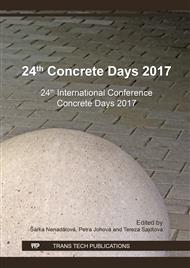p.64
p.70
p.76
p.82
p.88
p.94
p.102
p.107
p.115
Two Options of Self-Curing of High Performance Concrete
Abstract:
Some effects of self-curing on the mechanical properties of High Performance Concrete (HPC) are discussed in this paper. The matrix of HPC is very dense and it is very difficult to deliver the curing water into the cement matrix. Two different materials in different dosages were selected to examine self-curing. Polymer curing agent (PCA) was selected as the first, and 0.2% 0.4% 0.6% and 0.8% of PCA were added by weight of cement. This additive should allow the physicochemical binding of a larger portion of the mixing water and then release it slowly for better hydration without negative effects on the products. Pre-soaked slag of 0/4 mm was tested as another source of water for internal curing. The slag was also dosed in 10%, 15%, 20% and 30% volume of sand with the fraction 0/4 mm. Referential HPC was a high-dose cement that consumes a large amount of water for hydration. The water/cement ratio was 0.2. Metakaolin was added to improve the properties of fresh and hardened HPC.
Info:
Periodical:
Pages:
88-93
Citation:
Online since:
February 2018
Authors:
Price:
Сopyright:
© 2018 Trans Tech Publications Ltd. All Rights Reserved
Share:
Citation:


